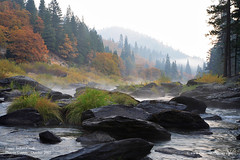 Plumas
County (10/22-23/2005) Plumas
County (10/22-23/2005)
Of all regions in California and probably elsewhere, I found the Plumas
County Visitor Bureau, its residents and friends to be most active
and enthusiastic about promoting fall foliage excursions. This is commendable
since it brings folks from other places that would otherwise not come
to the local communities - That was the case for us and several other
folks we met during the trip. From the same website, one can find an overview
of the region, what route to take to observe fall foliage, up-to-date
reports from leaf-peepers, where to stay, etc. all from the same website.
Many contributors send in their pictures, making it much easier to visualize.
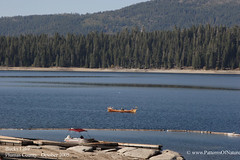 I
saw reports of foliage peaking in Plumas County while traveling in Eastern
Sierra. So, within a week of returning home, my wife and I drove to the
region for the weekend. We mapped a route that covers what I saw in the
report of peaked foliage a few days earlier - Bucks Lake, Highway 89,
Crescent Mills, and Indian Valley. I
saw reports of foliage peaking in Plumas County while traveling in Eastern
Sierra. So, within a week of returning home, my wife and I drove to the
region for the weekend. We mapped a route that covers what I saw in the
report of peaked foliage a few days earlier - Bucks Lake, Highway 89,
Crescent Mills, and Indian Valley.
Our trip through the valley up to route 162 was uneventful. As we began
to wind up the hills, the foliage began to show signs of autumn. The drive
itself was pleasant and scenic. We made several stops along the way to
take pictures of oaks, dogwoods, maples, and a whole range of other plants
that showing fall colors - many of which I don't know the names of. On
the way to Bucks Lake, we found a few aspen groves that had shed most
of the leaves. The trees still have appeals for photographic purposes.
Bucks Lake itself seems to be covered with evergreen though. I only found
a few places with golden foliage. The lake is quite scenic, with vacation
cabins along the road. I saw a few folks in their canoes or kayaks and
wished I were where they were. It definitely can be one of our vacation
destinations going forward.
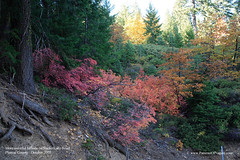 The
foliage became more interesting as we drove past Bucks Lake toward the
town of Quincy. We made multiple stops as we found hillsides covered
by foliage of a variety of colors, primarily from dogwoods, oak and maples.
A word of caution though - the road is windy and hilly. There are not
many turnouts along the way, so it's important to find a spot you can
park without inhibiting other vehicles. On that Saturday morning, the
traffic was light. Most locals seem to know that we were visitors and
cut us some slack. One need to look out for these gems, as they appear
in small clusters and not in large concentrations such as what you might
find on the June Lake Loop drive. The
foliage became more interesting as we drove past Bucks Lake toward the
town of Quincy. We made multiple stops as we found hillsides covered
by foliage of a variety of colors, primarily from dogwoods, oak and maples.
A word of caution though - the road is windy and hilly. There are not
many turnouts along the way, so it's important to find a spot you can
park without inhibiting other vehicles. On that Saturday morning, the
traffic was light. Most locals seem to know that we were visitors and
cut us some slack. One need to look out for these gems, as they appear
in small clusters and not in large concentrations such as what you might
find on the June Lake Loop drive.
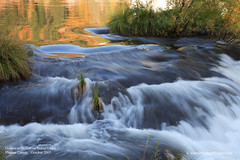 Indian
Creek was definitely a highlight as it accompanied Highway 89 on the
way to Crescent Mills. Rock outcrops from the creek banks or coming
up right from the middle of the creek made for wonderful photographic
subjects. There were several locations on the creek where oaks or Indian
Rhubarbs show their colors, contrasting with the background of green
pine needles. Again, one would need to pay attention to look for great
compositions. Generally speaking when I got there, much of the oaks on
the hillside were showing brownish yellow colors, probably reaching the
stage beyond peak colors. Next year, I'll have to plan better, or get
more up to date information for the specific location I plan to visit. Indian
Creek was definitely a highlight as it accompanied Highway 89 on the
way to Crescent Mills. Rock outcrops from the creek banks or coming
up right from the middle of the creek made for wonderful photographic
subjects. There were several locations on the creek where oaks or Indian
Rhubarbs show their colors, contrasting with the background of green
pine needles. Again, one would need to pay attention to look for great
compositions. Generally speaking when I got there, much of the oaks on
the hillside were showing brownish yellow colors, probably reaching the
stage beyond peak colors. Next year, I'll have to plan better, or get
more up to date information for the specific location I plan to visit.
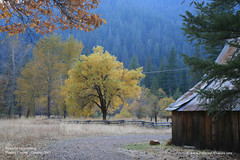 I
got a map of the Indian Valley from the owner of the B&B we stayed
at and drove around the valley, generally following Indian Creek toward
Antelope Lake. There were farms along the way with horses and cows
which would make good subjects against the autumn mountains as background.
Half way toward Antelope Lake, it was getting darker and we saw the
same pattern and decided to head back. After a nice dinner (better
than I thought possible at a small town), we took a walk on local streets
that had adequate lighting. We stayed away from Highway 89 as traffic
was moving at unsafe speed for pedestrians at night. The air was crisp
but not cold in that October night. I
got a map of the Indian Valley from the owner of the B&B we stayed
at and drove around the valley, generally following Indian Creek toward
Antelope Lake. There were farms along the way with horses and cows
which would make good subjects against the autumn mountains as background.
Half way toward Antelope Lake, it was getting darker and we saw the
same pattern and decided to head back. After a nice dinner (better
than I thought possible at a small town), we took a walk on local streets
that had adequate lighting. We stayed away from Highway 89 as traffic
was moving at unsafe speed for pedestrians at night. The air was crisp
but not cold in that October night.
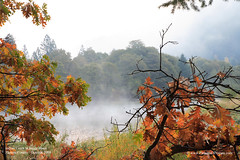 I
had seen reports about fog hovering above the creek early in the morning,
I headed out to Indian Creek again (for the third time) to see whether
I can catch similar moods. Nature did not disappoint. The whole area
was covered in fog, to the point where headlights must be turned on
for safety. And it was definitely chilly for me - around 35 degrees.
When I reached Indian Creek, the fog rose above tree level, making it
easier to see the creek and a layer of mist or fog (not sure what to
call it) right above water level. I was able to get a few good shots
along the creek. Then I turned back onto Arlington Rd and got a few more
pictures of fogs covering a small pond. I
had seen reports about fog hovering above the creek early in the morning,
I headed out to Indian Creek again (for the third time) to see whether
I can catch similar moods. Nature did not disappoint. The whole area
was covered in fog, to the point where headlights must be turned on
for safety. And it was definitely chilly for me - around 35 degrees.
When I reached Indian Creek, the fog rose above tree level, making it
easier to see the creek and a layer of mist or fog (not sure what to
call it) right above water level. I was able to get a few good shots
along the creek. Then I turned back onto Arlington Rd and got a few more
pictures of fogs covering a small pond.
Having seen similar patterns of foliage along Indian Creek and Indian
Valley and not sure where to go next with limited time, we decided to
drive through Lassen National Park on the way back to the bay area.
This drive was also quite nice. We made stops at Lake Almanor and along
the way to snap more pictures, but for the most part had to keep going
to stay on schedule. There were
several clusters of nice foliage along the road - one needs to keep an
eye out for them though. Lake Almanor seemed to be a stopover point
for migrating waterfowls. We saw many ducks and geese when we were there.
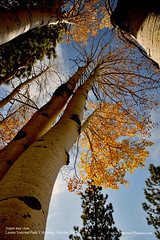 Lassen
National Park was quite scenic, especially on a clear autumn morning.
There was not a big crowd, making it easier and faster to get from one
place to another. There were several alpine lakes along the road that
did not require any hiking to get to. Even Summit Lake was within a short
walking distance. That was a nice treat for me, relating back to the
miles I had to hike the previous week to see lakes at Glacier trail and
Lone Pine Lake. Surprisingly, even at this elevation, I still found aspen
groves with some yellow/golden foliage among barren trees. Close to
Hat Lake, these trees looked especially nice against the backdrop of
Lassen Peak. As we moved toward the West entrance, we found further
nice foliage at Reflection and Manzanita lakes. Highway 44 toward Redding
also presented many nice dogwood clusters around Viola. Lassen
National Park was quite scenic, especially on a clear autumn morning.
There was not a big crowd, making it easier and faster to get from one
place to another. There were several alpine lakes along the road that
did not require any hiking to get to. Even Summit Lake was within a short
walking distance. That was a nice treat for me, relating back to the
miles I had to hike the previous week to see lakes at Glacier trail and
Lone Pine Lake. Surprisingly, even at this elevation, I still found aspen
groves with some yellow/golden foliage among barren trees. Close to
Hat Lake, these trees looked especially nice against the backdrop of
Lassen Peak. As we moved toward the West entrance, we found further
nice foliage at Reflection and Manzanita lakes. Highway 44 toward Redding
also presented many nice dogwood clusters around Viola.
All in all, it was a nice short trip from the bay area since I never
had the opportunity to go to the Plumas region of the state, although
it would take at least a long weekend to do justice for a visit. The
scenery was beautiful and the folks were friendly. Even though I could
probably do better if I get specific guidance from a local visitor center,
or perhaps called before I got on the road, I still managed to get several
good shots rivaling those I took in Eastern Sierra.
Until next time ...
Click on the image to the right for posted pictures
from this trip.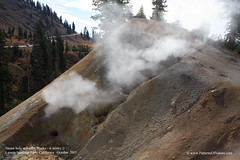
|
|
|